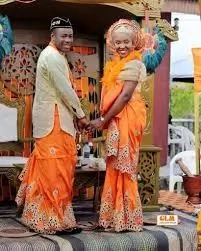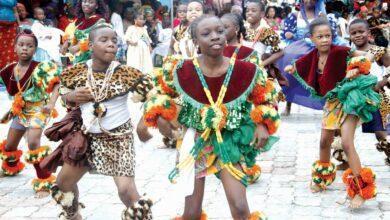Traditional Marriage Rite In Ibibio Land
The Performance in Ibibio traditional marriage ceremonies is typically characterized by Playing ‘games’ and creating a most relaxing and pleasurable atmosphere is so much that the entire exercise is often seen as a game (ndọ odo mbre).
The traditional marriage is divided into stages. Each stage comes with its own dynamics and accompanied by certain events which must take place for a traditional marriage ceremony to be recognized or regarded as complete and successful. The various stages are categorized into five sections described as follows.
👉 Relocate to Canada Today!
Live, Study and Work in Canada. No Payment is Required! Hurry Now click here to Apply >> Immigrate to Canada
Opening entertainment –This section begins with the groom’s direct entourage excluding all the invited guests are escorted to the sitting room in the family house by the maidens or women of the bride’s family.
There in the sitting room an array of foods are displayed, ranging from boiled and sliced cassava chippings (edita iwa) to cassava fofo, pounded yam with assorted soups roasted palm fruits (aduek eyop), palm kernel seeds (isip), and in the modern era, fried rice garnished with salad.
The essence of such opulent and fabulous display of foods is to satisfy the groom and his entourage assure them that the prospective bride understands much about food and will be able to take care of the husband and feed him well.
Then a woman knowledgeable in the preparation of all the recipes then clearly presents, explains, and tastes each food item before the groom’s entourage is served.
Negotiation phase –This is the section where the two families are represented by a negotiating team to negotiate on the list items of things the groom is supposed to pay to the bride’s family.
Therefore what the bride’s family takes into the house at the end of the day in terms of quantity and quality will depends on the negotiating skill of the chief negotiators on either side rather than on the “List” earlier submitted and even discussed in private by the two families.
This phase is usually the most exciting as confirmation will be made as to whether all the requirement of the list has been fulfilled by the groom.
In contemporary days it is expected that all that is required would have been paid before the day of the traditional wedding.
👉 Relocate to Canada Today!
Live, Study and Work in Canada. No Payment is Required! Hurry Now click here to Apply >> Immigrate to CanadaThe search –In this section the bride, is ‘hidden’ from view and upon confirmation that all the items required in the list has been completed, the groom’s team, openly demand the appearance of the subject of their mission – the bride.
They will then be requested to organize a search party during which a woman in the bride’s family will be persuaded to lead the search team.
She will make demands and do at least two trips, appearing with different females other than the bride (usually an old woman and later a little girl).
And by the third trip, the bride is escorted with a long dance train consisting of her females age group , friends, and family.
The bride is elaborately dressed and decked with trinkets and bracelets from the hair to the ankles. This moment signifies a triumphant moment for both parties after a long battle of wits.
The Mock Resistance –This section is a bit of display of drama of a Youngman who had interest earlier on the bride but later lost out but will however insist for her as bride.
After which the defeated suitor weeps out of the scene while the process of exchange of drinks and pledges among the bride, groom, and parents of the two is being arranged.
The Nuptial dance – This is the section where the bride and the groom are joined as husband and wife and here they are made to perform their first public function.
The new couples dance to the floor to music supplied by traditional band group. They are presented with both cash and other gift items what is usually described as the “first joint public activity by the new couple” usually marks the end of the ceremony of joining a young man and a young woman in an everlasting union of two persons, two families, and sometimes two villages or two tribes, or two cultures.
The new couple dances to music supplied by a band set or traditional dance group. They are “sprayed” with coins (in the past) and currency notes of which this has currently been prohibited by the Federal Government of Nigeria in a bid to “give respect” to one of the country’s national symbols – the Naira.
Other performances. This include “blocking” the entrance to the village where the groom is not an indigene by young men who will inform the grooms family the people keeps watch of the village and would demand that some things be presented as gift such as Items taken from the groom may include one football, a packet of cigarettes, a bottle of spirit, a bottle of wine, and cash as negotiated.
The process that gets the audience to watch the couple and their families is in itself a rite. Wine is poured, drinks are poured, sipped and exchanged among the bride, groom, and their parent and currently Pastors or religious leaders are brought to pray and confirm the traditional performance. Change in performance
According to Skolnick (2006) the two important changes in marriage in western societies are increased equality between the partners even though the men are more favored and the change of emphasis from social reproduction to intimacy as the primary motive for marriage.
This has also affected the Ibibio’s with a shift of women usually heard at the back house to actively participate I in business discussions.
The notion of equality of the sexes is greater in educated families and families with religious beliefs where religion encourages partnership rather than servile relationships. But traditional religionists and less educated people do not regard women as equal partners in marriage.
However with increase in the level of education of the people there is greater t tendency towards intimacy in marriages in Ibibio land as against the past when farm work was highly upheld rather than for procreation. But procreation still remains remain the basic reason for marriage.
The change experienced recently in marriage in Ibibio land has to do with conducting the marriage within a short time and not allowing it to linger to the late hour and the fact that negotiation is concluded prior to the public ceremony.
At present, negotiations take place between the two families in private and all the things to be given and received are concluded prior to the public ceremony. And the cost of white wedding” has changed very little.
Change in performance
According to Skolnick (2006) the two important changes in marriage in western societies are increased equality between the partners even though the men are more favored and the change of emphasis from social reproduction to intimacy as the primary motive for marriage.
This has also affected the Ibibio’s with a shift of women usually heard at the back house to actively participate I in business discussions.
The notion of equality of the sexes is greater in educated families and families with religious beliefs where religion encourages partnership rather than servile relationships. But traditional religionists and less educated people do not regard women as equal partners in marriage.
However with increase in the level of education of the people there is greater t tendency towards intimacy in marriages in Ibibio land as against the past when farm work was highly upheld rather than for procreation. But procreation still remains remain the basic reason for marriage.
The change experienced recently in marriage in Ibibio land has to do with conducting the marriage within a short time and not allowing it to linger to the late hour and the fact that negotiation is concluded prior to the public ceremony.
At present, negotiations take place between the two families in private and all the things to be given and received are concluded prior to the public ceremony. And the cost of white wedding” has changed very little.





